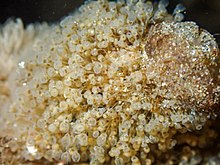| Entoprocta | |
|---|---|

| |
| Barentsia ramosa | |
| Scientific classification | |
| Domain: | Eukaryota |
| Kingdom: | Animalia |
| Subkingdom: | Eumetazoa |
| Clade: | ParaHoxozoa |
| Clade: | Bilateria |
| Clade: | Nephrozoa |
| (unranked): | Protostomia |
| (unranked): | Spiralia |
| Superphylum: | Lophotrochozoa |
| Clade: | Lophophorata |
| Phylum: | Entoprocta Nitsche, 1870 |
| Families | |
| |
Entoprocta /ɛntoʊˈprɒktə/ (lit. 'inside rectum/anus'), or Kamptozoa /kæm(p)təˈzoʊə/, is a phylum of mostly sessile aquatic animals, ranging from 0.1 to 7 millimetres (0.004 to 0.3 in) long. Mature individuals are goblet-shaped, on relatively long stalks. They have a "crown" of solid tentacles whose cilia generate water currents that draw food particles towards the mouth, and both the mouth and anus lie inside the "crown". The superficially similar Bryozoa (Ectoprocta) have the anus outside a "crown" of hollow tentacles. Most families of entoprocts are colonial, and all but 2 of the 150 species are marine. A few solitary species can move slowly.
Some species eject unfertilized ova into the water, while others keep their ova in brood chambers until they hatch, and some of these species use placenta-like organs to nourish the developing eggs. After hatching, the larvae swim for a short time and then settle on a surface. There they metamorphose, and the larval gut rotates by up to 180°, so that the mouth and anus face upwards. Both colonial and solitary species also reproduce by cloning — solitary species grow clones in the space between the tentacles and then release them when developed, while colonial ones produce new members from the stalks or from corridor-like stolons.
Fossils of entoprocts are very rare, and the earliest specimens that have been identified with confidence date from the Late Jurassic. Most studies from 1996 onwards have regarded entoprocts as members of the Trochozoa, which also includes molluscs and annelids. However, a study in 2008 concluded that entoprocts are closely related to bryozoans. Other studies place them in a clade Tetraneuralia, together wit molluscs.
- ^ Zhang, Zhifei; et al. (January 2013). "A sclerite-bearing stem group entoproct from the early Cambrian and its implications". Scientific Reports. 3: 1066. Bibcode:2013NatSR...3E1066Z. doi:10.1038/srep01066. PMC 3548229. PMID 23336066.
- ^ Todd, J. A.; Taylor, P. D. (1992). "The first fossil entoproct". Naturwissenschaften. 79 (7): 311–314. Bibcode:1992NW.....79..311T. doi:10.1007/BF01138708. S2CID 44229586.